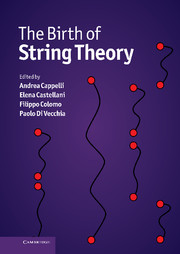Book contents
- Frontmatter
- Contents
- List of contributors
- Photographs of contributors
- Preface
- Abbreviations and acronyms
- Part I Overview
- EARLY STRING THEORY
- Part II The prehistory: the analytic S-matrix
- Part III The Dual Resonance Model
- 10 Introduction to Part III
- 11 From the S-matrix to string theory
- 12 Reminiscence on the birth of string theory
- 13 Personal recollections
- 15 Early string theory at Fermilab and Rutgers
- 15 Dual amplitudes in higher dimensions: a personal view
- 16 Personal recollections on dual models
- 17 Remembering the ‘supergroup’ collaboration
- 18 The ‘3-Reggeon vertex’
- Part IV The string
- TOWARDS MODERN STRING THEORY
- Part V Beyond the bosonic string
- Part VI The superstring
- Part VII Preparing the string renaissance
- Appendix A Theoretical tools of the Sixties
- Appendix B The Veneziano amplitude
- Appendix C From the string action to the Dual Resonance Model
- Appendix D World-sheet and target-space supersymmetry
- Appendix E The field theory limit
- Index
15 - Early string theory at Fermilab and Rutgers
from Part III - The Dual Resonance Model
Published online by Cambridge University Press: 05 May 2012
- Frontmatter
- Contents
- List of contributors
- Photographs of contributors
- Preface
- Abbreviations and acronyms
- Part I Overview
- EARLY STRING THEORY
- Part II The prehistory: the analytic S-matrix
- Part III The Dual Resonance Model
- 10 Introduction to Part III
- 11 From the S-matrix to string theory
- 12 Reminiscence on the birth of string theory
- 13 Personal recollections
- 15 Early string theory at Fermilab and Rutgers
- 15 Dual amplitudes in higher dimensions: a personal view
- 16 Personal recollections on dual models
- 17 Remembering the ‘supergroup’ collaboration
- 18 The ‘3-Reggeon vertex’
- Part IV The string
- TOWARDS MODERN STRING THEORY
- Part V Beyond the bosonic string
- Part VI The superstring
- Part VII Preparing the string renaissance
- Appendix A Theoretical tools of the Sixties
- Appendix B The Veneziano amplitude
- Appendix C From the string action to the Dual Resonance Model
- Appendix D World-sheet and target-space supersymmetry
- Appendix E The field theory limit
- Index
Summary
Today there is a very noticeable tension between string theory and phenomenology in particle physics. It is interesting to muse over the roots of this situation in the very early days of string theory. In this personal account of a small part of the ancient history I review some developments in the string theory groups at Fermilab and Rutgers University in the early Seventies. The present conflict between string theory and phenomenology of particle physics is probably more easily understandable than that of the early days. At its base today is, if sometimes subterranean, a debate over the relative federal funding that the two areas should properly receive. Among phenomenologists there is the perception that progress in string theory has slowed noticeably while still attracting a disproportionate fraction of students and postdoc positions. On the other side there is the feeling that the killing of the Superconducting Super Collider (SSC) project has led to a pronounced drought in the qualitatively new experimental discoveries that could feed phenomenological work. An exception is the confirmation of neutrino masses with well-measured mass splittings and mixing angles. In the beginning, however, string theory (or dual model theory) was totally devoted to the building of a theory of strong interactions that could deal directly with the large amount of data on hadronic phenomena being accumulated at Brookhaven, CERN, and Serpukhov.
One might, therefore, have expected a long honeymoon between dual model theorists and phenomenologists. This however never materialized.
- Type
- Chapter
- Information
- The Birth of String Theory , pp. 193 - 197Publisher: Cambridge University PressPrint publication year: 2012



